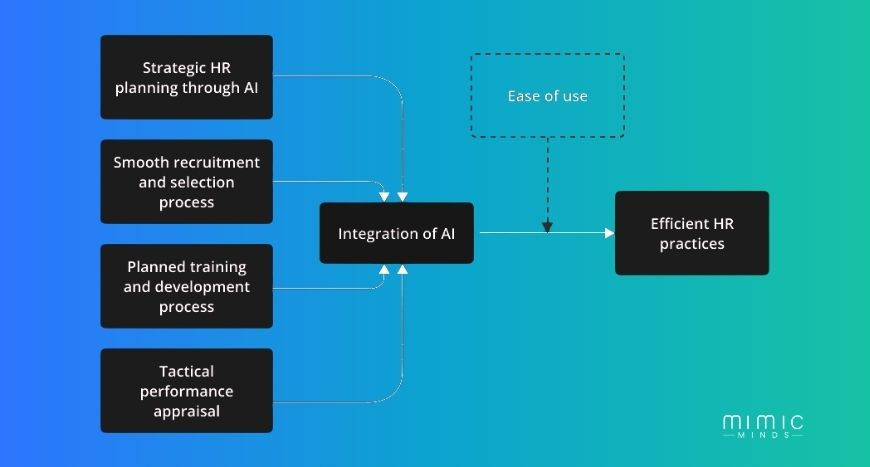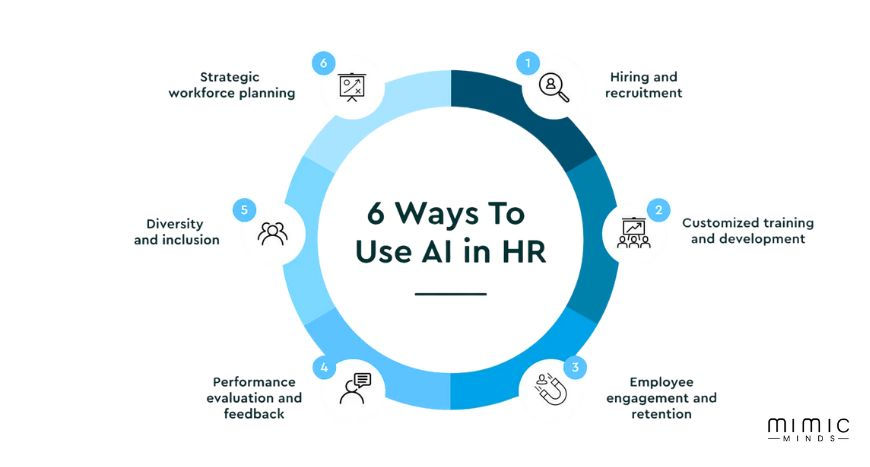AI in HR: How AI Is Transforming the Future of HR
- Mimic Minds
- Sep 18, 2025
- 5 min read

The human resources landscape is rapidly evolving with the integration of artificial intelligence. AI in HR is no longer a futuristic concept—it’s actively reshaping recruitment, onboarding, performance management, and employee engagement. By leveraging AI, organizations can streamline operations, make data-driven decisions, and enhance employee experiences.
This article explores how AI in HR works, its key applications, benefits, and how it will redefine the future of HR management.
Table of Content
What Is AI in HR?
AI in HR refers to the use of artificial intelligence technologies to automate, optimize, and enhance human resource functions. From recruitment to employee engagement, AI in HR helps organizations make data-driven decisions while reducing manual workload.
With AI in HR, organizations can:
Predict talent needs and workforce trends
Streamline candidate screening and hiring
Improve employee satisfaction through personalized experiences
Reduce administrative overhead
In essence, AI in HR acts as a digital assistant, enabling HR teams to focus on strategy and employee development rather than repetitive tasks.
How AI in HR Works

AI in HR operates through a combination of data analytics, machine learning algorithms, and natural language processing. These tools analyze employee data, track performance metrics, and provide actionable insights.
Key components of AI in HR include:
Resume Screening Algorithms: Quickly identify top candidates based on experience and skills
Predictive Analytics: Forecast employee turnover and future hiring needs
Chatbots for HR Queries: Provide instant answers to employee questions on benefits, policies, or payroll
Sentiment Analysis: Gauge employee satisfaction and engagement levels
Automation of Administrative Tasks: Handle payroll, leave requests, and attendance management
These tools allow HR professionals to make informed decisions and improve overall workforce productivity. For a deeper dive into AI-driven autonomous systems, check our article on Agentic AI.
Real-World Applications of AI in HR

AI in HR is being adopted across industries for a variety of purposes. Here are some practical applications:
Recruitment & Talent Acquisition
AI in HR streamlines hiring by automatically sourcing candidates, screening resumes, and scheduling interviews, significantly reducing time-to-hire.
Employee Engagement & Retention
AI-driven platforms monitor engagement levels, provide feedback, and suggest interventions to retain top talent.
Performance Management
AI in HR analyzes productivity metrics, identifies skill gaps, and recommends personalized training programs.
Learning & Development
Adaptive learning platforms powered by AI in HR help employees upskill through personalized courses and feedback.
Workforce Planning
AI tools forecast workforce needs, optimize resource allocation, and support strategic decision-making.
Organizations can explore more insights about AI-driven tools and digital human interaction in our Conversational AI in Education article.
AI in HR vs Traditional HR: Key Differences
Feature | Traditional HR | AI in HR |
Data Analysis | Manual, prone to bias | Automated, data-driven insights |
Recruitment | Time-consuming, subjective | Efficient, objective, predictive |
Employee Feedback | Periodic surveys | Continuous sentiment analysis |
Decision Making | Based on experience | Augmented by AI predictions |
Workload | High administrative burden | Reduced with automation |
AI in HR enhances efficiency, accuracy, and scalability, unlike traditional HR methods that rely heavily on manual processes. For a comparison between AI-driven systems and traditional approaches, see Agentic AI vs Generative AI.
How AI in HR Is Transforming Organizations
The integration of AI in HR is reshaping organizational processes:
Enhanced Recruitment & Talent Matching
AI in HR tools evaluate candidate skills, culture fit, and past performance to match the best talent with roles.
Data-Driven Employee Development
AI in HR identifies skill gaps and recommends targeted training to improve workforce capability.
Predictive Workforce Management
Predictive analytics in AI in HR anticipate attrition risks, workload distribution, and future hiring needs.
Personalized Employee Experience
AI in HR provides tailored recommendations, learning paths, and benefits insights to enhance employee satisfaction.
Optimized Decision-Making
AI in HR analyzes large datasets to guide management in strategic HR decisions, from compensation planning to succession management.
For organizations aiming to combine digital human capabilities with influencer-style engagement, refer to Why AI Avatars Are the Future of Influencer Marketing.
Challenges and Considerations
While AI in HR provides significant advantages, there are challenges:
Data Privacy & Security: Sensitive employee data must be handled responsibly.
Bias in Algorithms: AI in HR can inherit biases from historical data.
Change Management: HR teams need training to adopt AI-powered tools effectively.
Ethical Considerations: Decisions affecting employees must be transparent and fair.
Organizations should balance automation with human oversight to ensure AI in HR enhances, rather than replaces, human judgment.
The Road Ahead: Why AI in HR Matters
AI in HR is no longer optional; it’s becoming essential for organizations to stay competitive. Companies leveraging AI in HR can expect:
Faster, smarter HR processes
Improved employee engagement and retention
Better talent acquisition and workforce planning
Strategic insights to guide leadership decisions
Early adopters of AI in HR gain a competitive advantage by creating agile, data-driven HR functions.
FAQs: AI in HR
Q1. What is AI in HR?
AI in HR refers to the use of artificial intelligence to optimize recruitment, employee engagement, performance management, and workforce planning.
Q2. How does AI in HR improve recruitment?
AI in HR automates resume screening, candidate matching, and interview scheduling, reducing hiring time and bias.
Q3. Can AI in HR analyze employee performance?
Yes, AI in HR tracks performance metrics, identifies skill gaps, and recommends personalized development plans.
Q4. Is AI in HR cost-effective?
While AI in HR requires initial investment, it reduces manual workload and improves efficiency, making it cost-effective over time.
Q5. Will AI in HR replace HR professionals?
AI in HR complements human HR teams by automating repetitive tasks, enabling professionals to focus on strategy and employee experience.
Q6. What industries benefit from AI in HR?
AI in HR is useful in technology, healthcare, finance, manufacturing, education, and almost every sector with a workforce to manage.
Q7. How can organizations implement AI in HR safely?
Organizations should ensure data privacy, minimize algorithmic bias, and combine AI insights with human oversight for ethical HR practices.
Conclusion
AI in HR is transforming how organizations manage their workforce. From recruitment and performance management to engagement and predictive analytics, AI in HR allows HR teams to operate more strategically, efficiently, and accurately.
Embracing AI in HR today means empowering HR professionals to focus on innovation, employee satisfaction, and organizational growth while leaving repetitive tasks to intelligent systems.
About Mimic Minds
Mimic Minds specializes in developing advanced AI and digital human solutions, including AI avatars and conversational AI platforms. We create tools that help organizations innovate, engage, and automate processes while maintaining human-centric experiences.
Contact us for further information: info@mimicminds.com




Comments